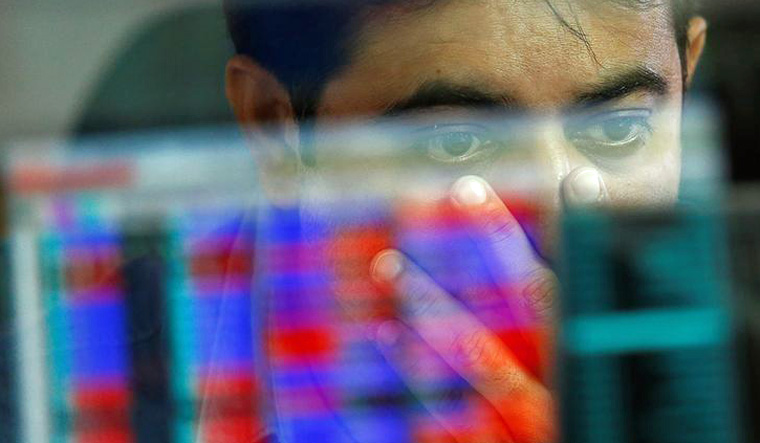Equity markets witnessed another volatile session on Wednesday and ended lower for the second straight day, tracking weakness in other markets like Japan and China. The BSE Sensex closed 254 points or 0.4 per cent lower to close the day at 59,413.27 points. The broader NSE Nifty50 index ended 37 points or 0.2 per cent lower at 17,711.30 points.
The Sensex scaled the 60,000 peak last Friday and hit a life high of 60,412 on September 27. It took just 160 trading sessions for the benchmark index’s journey from 50,000 to 60,000. From the life high, the Sensex has now fallen 1,000 points.
Avinash Gorakshakar, director research at Profitmart Securities, points out that it's only some of the heavyweights like Reliance Industries, Bajaj Finance, TCS, HDFC Bank etc, which have driven the index higher, but a broad-based rally is not there. With valuations at the upper end, any further rally like what we have seen this year is capped, he told THE WEEK.
“Valuations are little scary now and you need to be very selective and careful. This is not a time to bet on any and every company.”
Other analysts also echo similar sentiments.
“To have a sustained bull run from here onwards, after the linear bull run that we have seen and the volume with which it has risen, is starting to look a bit difficult. You will now start tracking a whole host of factors very seriously and seeing if things are actually happening on ground or not,” Mayuresh Joshi, head of equity research India at William O’Neil and Company, told THE WEEK.
There are several points to watch out for. Companies will start reporting their second quarter earnings next month. After the first quarter was impacted due to the second wave of COVID-19, how things pan out now and what’s the outlook for the rest of the financial year and the next year will be closely watched.
“A lot of bankers after the Q1 results gave confidence to the market they are seeing good recovery. Whether it's actually happening and they are walking the talk will have to be watched out for,” said Joshi.
Automobile companies have already warned that semiconductor issues will have an impact on their sales growth this quarter.
Commodity prices continue to rise and that will have a bearing across sectors, too. Furthermore, supply chain issues also remain in many areas. All this could have a bearing on corporate earnings.
There are other near-term concerns like the Evergrande debt crisis or the electricity crisis in China, which the market is hoping the government there will address and avoid the effects spilling over to other markets.
A major reason that has continued to drive the markets is ample liquidity in the system, driven by easy money policies by central banks. Record low interest rates have also driven investors to stocks and mutual funds.
But, at these levels earnings growth will be extremely crucial.
“For the market to sustain the rally, the corporate earnings have to hold up. Now the earnings trajectory has to be really strong and consistent,” said Joshi.
Indian equities still offer “relatively better” risk-reward from a medium to long-term perspective, although the stretched valuations and Federal Reserve meeting could bring some volatility, Jitendra Gohil, head of India equity research at Credit Suisse, said in a report this month.
Where are the pockets of opportunity?
“We continue to recommend that investors stay invested in Indian equities in line with their strategic weight in portfolios, albeit with lower risks. We suggest investors reduce the beta of their portfolio by cutting exposure to small and midcap stocks, while adding more large cap companies,” said Gohil.
Credit Suisse prefers banking and fast moving consumer goods companies in the near-term, while it also expects the auto sector outlook to start improving in the coming quarters.
Gorakshakar of Profitmart says one can still take a reasonable amount of risk in sectors like manufacturing, capital goods and agri-chemicals if one has a perspective of two years or more. However, from the next 12 month perspective, much of the expected growth has been factored in the price, he added.
Joshi of William O’Neil also feels the IT sector still looks good structurally and if there is some pullback, it's a reasonable sector to bet on. The renewable energy space and companies betting on it will also see a significant traction in the next few months and years. With countries looking to de-risk and reduce some of their dependencies on Chinese suppliers, select domestic chemical companies could also do well, he added.
“Stay cautious. Have a sector/stock specific approach, monitor data points, see how macros are shaping and then take a call. Being too aggressive at this juncture will be risky,” urged Joshi.





